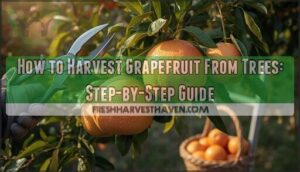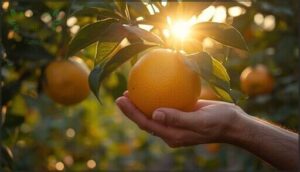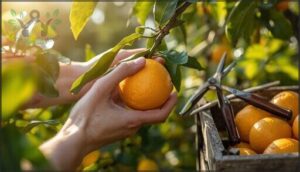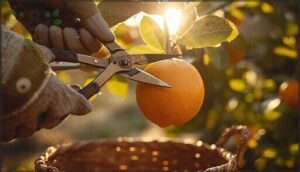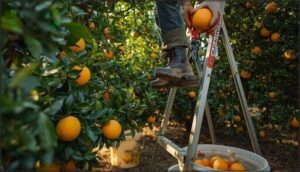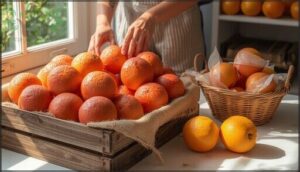This site is supported by our readers. We may earn a commission, at no cost to you, if you purchase through links.
Most backyard growers pull their grapefruit weeks too early, biting into tart, disappointing fruit that needed another month on the branch. Unlike apples or peaches that ripen after picking, grapefruit won’t sweeten once separated from the tree—timing is everything.
The difference between mediocre and exceptional comes down to recognizing subtle shifts in color, weight, and aroma that signal peak maturity. You’ll need more than a ladder and good intentions to master harvesting grapefruit from trees. Proper technique protects both fruit quality and tree health, determining whether you’re stocking your kitchen with grocery-store equivalents or creating something genuinely excellent.
The process demands attention to detail, from the angle of your clippers to the temperature of your morning harvest.
Table Of Contents
Key Takeaways
- Grapefruit won’t ripen or sweeten after being picked, so you must wait for multiple ripeness indicators—including color shift to yellow or pink, firm-but-yielding texture, heavy weight for size, and a strong citrus aroma when the peel is scratched—before harvesting.
- Proper harvesting technique requires using sanitized clippers to cut stems cleanly within a quarter-inch of the fruit, avoiding the twist-and-pull method when resistance occurs, and keeping drop heights under 4 inches to prevent bruising that accelerates spoilage.
- Storage success depends on immediate cooling within 24 hours of harvest, maintaining temperatures between 10-15°C with 85-95% humidity, and avoiding temperatures below 7°C to prevent chilling injury that destroys fruit quality.
- Indoor and container-grown grapefruit trees need 6-12 hours of direct sunlight daily, citrus-specific fertilizer every 4-6 weeks, and careful monitoring of ripeness signs since confined growing conditions alter ripening timelines compared to outdoor trees.
Signs Your Grapefruit is Ready to Harvest
You can’t just yank fruit off the tree and hope for the best—grapefruit demands that you know exactly when it’s hit its peak. Miss the signs, and you’re stuck with sour disappointment or overripe mush.
Grapefruit demands you know exactly when it’s hit its peak—miss the signs, and you’re stuck with sour disappointment or overripe mush
Here’s how to read your tree like a pro and claim those grapefruits at their absolute prime.
Color Changes and What They Mean
Watch for grapefruit peel changes as your primary visual cue for fruit maturation. You’ll notice ripening signs when at least half the rind shifts from green to vibrant yellow or pink—that’s when color intensity signals readiness. Warmer climates deepen this transformation dramatically. Red light can boost carotenoid content by 62%, enhancing both color and nutritional punch. Firmness paired with these visual cues confirms you’re hitting peak ripeness.
Understanding citrus tree care is vital for peak grapefruit harvest.
Size and Weight Indicators
Beyond color, size and weight indicators give you command over harvest timing. Ripe grapefruit typically measure 4–6 inches in diameter and weigh 1 to 2.5 pounds—that weight correlation signals peak juice content. Grab several fruits of similar size; the heaviest wins. Fruit density doesn’t lie.
Star Ruby varieties often exceed 400 grams, while California cultivars run lighter at 200–350 grams depending on ripeness and growing conditions. Understanding the citrus ripening process is essential for ideal harvesting.
Firmness and Texture Checks
Firmness testing gives you tactile proof of ripeness. Squeeze gently—ripe grapefruit yields slightly but bounces back, hitting that 17–20 N sweet spot. Mushy spots or wrinkles? That’s overripe territory. You’re targeting taut, smooth skin with just enough give.
Texture analysis matters: firm fruit at harvest maintains better juice content and sweetness through storage, while soft fruit breaks down fast.
Aroma and Scent Cues
Your nose doesn’t lie. Scratch the peel near the stem—ripe grapefruit releases a tangy-sweet citrus punch loaded with volatile emissions like d-limonene and sulfur compounds. This fragrance richness signals peak maturity. If there’s barely any scent, the fruit’s underripe. Strong aroma compounds mean you’re hitting that harvest window where sweetness and juice content max out. Trust scent detection as your field shortcut.
- Scratch peel gently to release citrus aromatics
- Detect tangy-sweet fragrance at blossom end
- Weak aroma signals underripe fruit
- Strong scent correlates with high sugar content
- Aroma peaks between 9 AM and noon
Performing a Taste Test
Slice one grapefruit from your tree and run your own sensory analysis. A 9-point hedonic scale isn’t required—just note the balance between sweetness and tartness.
Ripe fruit delivers bold flavor profiles with soluble solids above 8.5 °Brix. Excessive bitterness or weak aroma means it’s too early.
Taste panels confirm that consumer preferences hinge on this simple test—your palate reveals fruit quality and ideal harvesting timing instantly.
Best Time to Harvest Grapefruit
Timing your grapefruit harvest can make the difference between tart disappointment and perfectly sweet fruit. You can’t just pick whenever the mood strikes—grapefruits have specific windows when they’re at their peak, and those windows shift depending on where you live and what you’re after.
Let’s break down exactly when to harvest for the best results.
Seasonal Harvesting Windows
You’ll find that harvest schedules for grapefruit align with distinct seasonal windows that vary by cultivar and location. Most commercial operations target these prime periods for ideal fruit maturation:
- November through May marks the peak harvest time in Florida and other subtropical regions, when fruit ripening reaches ideal sweetness levels.
- March to September works best for Star Ruby varieties, allowing extended harvest timing flexibility.
- Late April through September captures Australia’s ideal window, maximizing fruit quality and market readiness.
Timing your grapefruit harvesting within these windows ensures you’re picking at peak ripeness.
Regional and Climate Considerations
Your grapefruit’s harvest window shifts dramatically based on where you’re growing. In USDA plant hardiness zones 9b through 11—think subtropical Florida or tropical regions—warm temperatures deliver sweeter fruit and extended September-to-June seasons. California’s drier climate pushes harvest later, January through August.
Temperature effects dictate everything: soil requirements, humidity levels, and wind protection all vary by climate zones, shaping your subtropical agriculture strategy.
Timing for Maximum Sweetness
Want the sweetest grapefruit possible? Harvest timing controls sugar content and transforms your fruit’s flavor profile. Here’s your ideal picking strategy:
- Wait for late-season maturity—November through March delivers peak sweetness as sugar accumulation maximizes
- Let fruit ripen fully on the tree for balanced sweet-tangy profiles
- Test firmness and aroma to confirm ripeness before cutting
- Taste-test first to verify sugar-acid balance hits your target
Step-by-Step Grapefruit Harvesting Techniques
You’ve nailed down the timing—now it’s time to get those grapefruits off the tree without wrecking them. The right approach makes all the difference between perfect fruit and a bruised mess that won’t last the week.
Here’s everything you need to harvest like a pro, from the gear in your hands to the cuts you make.
Tools Needed for Harvesting
You’ll need a few essential gardening tools and equipment to take command of your harvest. Handheld clippers or pruning shears—disinfected every four hours—cut stems cleanly without damaging the rind.
Padded picking bags reduce bruising by 25%, while sturdy aluminum ladders grant access to upper branches.
For larger operations, mechanical harvesters process thousands of kilograms per hour, though they require careful calibration to minimize fruit damage.
Proper Picking Methods
Master the twist-and-pull method: grasp your ripe grapefruit firmly at the base, rotate it gently until the stem releases cleanly from the branch. This classic harvesting technique works perfectly for fruit that’s reached peak ripeness.
If resistance persists, switch to your sanitized clippers and cut the stem within a quarter-inch of the calyx—this prevents tearing and keeps your harvest unblemished for storage.
Avoiding Damage During Harvest
Sharp clippers make the difference between impeccable fruit and ruined harvests. Protecting your grapefruit during harvesting techniques demands precision:
- Cut stems cleanly with sanitized pruning shears—never yank or twist and pull roughly
- Harvest afternoons when fruit protection is ideal due to elastic skin
- Keep drop heights under 4 inches during gentle handling
- Cool fruit within 2 hours for essential post-harvest care
- Maintain firm ground to prevent accidental damage prevention failures
Safety and Sanitation Tips
Beyond protecting fruit, you need to protect yourself. Ladder safety during grapefruit harvesting means three-legged ladders require firm ground and three-point contact—never climb past the third rung from the top.
Worker protection demands cleated shoes on muddy terrain, daily equipment sanitization of clippers and buckets, and harvest hygiene that keeps ground fruit out of bins.
This citrus tree care prevents contamination.
Handling and Storing Freshly Picked Grapefruit
Your harvest doesn’t end when the fruit leaves the tree. How you handle and store your grapefruits in those first few hours determines whether they’ll stay fresh for days or spoil within hours.
Let’s break down the essentials that’ll keep your citrus in peak condition.
Preventing Bruising and Spoilage
You hold the key to fruit handling that transforms harvest success. Keep drop heights under 20 centimeters—this bruise prevention tactic slashes damage by up to 89%. Harvest during cool mornings when firmness peaks, then move your grapefruit to washing and waxing immediately.
Use padded containers for post-harvest care, handle gently during sorting, and remove any bruised fruit quickly for excellent spoilage control.
Storage Temperature and Conditions
Once you’ve mastered bruise prevention, temperature control becomes your next weapon for preservation.
Store California and Arizona grapefruits at 14-15°C for 4-6 weeks of ideal storage. Florida and Texas varieties demand cooler conditions—around 10°C. Maintain 85-95% humidity levels to prevent dehydration.
Pre-cool your fruit within 24 hours using forced-air cooling methods, and avoid temperatures below 7°C to sidestep chilling injury that destroys your harvest.
Shelf Life and Freshness Maintenance
Proper grapefruit storage and preservation extends your harvest’s power. Whole grapefruits command 2-3 weeks at room temperature, yet refrigeration unleashes 5-6 weeks of peak quality. Cut portions demand immediate action—same-day consumption or 2-3 days refrigerated in airtight containers.
Master these freshness preservation tactics:
- Store whole fruit in your refrigerator’s crisper at 40-45°F
- Keep cut grapefruit sealed with paper towels absorbing excess moisture
- Freeze juice or segments for 3-4 months maximum usability
- Apply wax coating with polyethylene bags reducing moisture loss
- Handle fruit gently preventing mechanical damage that accelerates decay
Spotting and Removing Spoiled Fruit
Vigilance protects your harvest’s integrity. Inspect fruit regularly for soft spots, mold, brown discoloration, or fermented odors—all spoilage signs demanding immediate removal. Damaged grapefruit accelerates decay in neighboring fruit through ethylene release, compromising tree hygiene and harvest timing.
Remove affected specimens promptly during fruit inspection to maintain freshness and prevent pathogen spread. This practice ensures ideal fruit selection, aids proper ripening time, and maximizes your grapefruit harvesting guide success.
Tips for Indoor and Small-Space Grapefruit Harvesting
Growing grapefruit in containers or indoors doesn’t mean you’re stuck with guesswork when harvest time rolls around. You’ll need to adjust your approach to account for limited space, different light conditions, and the unique needs of potted citrus.
Here’s what you need to know to harvest successfully from your indoor or small-space grapefruit trees.
Indoor Ripening Signs
When you bring grapefruit indoors to finish ripening, watch for key fruit ripeness signals that tell you they’re ready. Color shifts from green to vibrant yellow or pink mark advancing ripening stages, while fruit softening under gentle pressure indicates progress.
Indoor conditions and natural ethylene production accelerate fruit ripening—usually within days. The sweet citrus aroma intensifies as grapefruit ripeness peaks, signaling it’s time to taste-test for that perfect balance.
Harvesting Grapefruit From Potted Trees
Container-grown grapefruit trees demand your attention differently than outdoor orchards. Your indoor citrus reacts to closer monitoring, making harvest timing strategies critical for fruit yield optimization.
Follow these grapefruit harvesting tips for potted tree care:
- Check firmness daily—your fruit ripens on its own timeline
- Twist gently until stems release without force
- Use clean pruning shears for tree maintenance and health
- Monitor your grapefruit variety selection for unique ripening patterns
Harvesting from your grapefruit tree becomes second nature with practice and tree pruning techniques knowledge.
Special Care for Indoor Citrus Trees
Your indoor citrus thrives when you master light requirements—aim for 6 to 12 hours of bright, direct sunlight daily.
Balance water management by letting topsoil dry between waterings, preventing root rot. Humidity control above 50% keeps leaves healthy, while nutrient balance through citrus-specific fertilizer every 4 to 6 weeks fuels growth.
Monitor pest prevention regularly, checking for scale insects and aphids on your indoor grapefruit tree.
Frequently Asked Questions (FAQs)
How do I protect grapefruit trees from pests and diseases?
Protecting your grapefruit tree starts with smart pest control methods and disease management through regular tree sanitation.
Use organic solutions like neem oil, practice integrated practices combining physical barriers with copper fungicides, and maintain proper orchard management.
Can I harvest grapefruit in the rain?
You can harvest grapefruit in the rain, but it’s not ideal. Wet fruit attracts mold and spoils faster.
Wait for dry conditions when possible to preserve quality and extend shelf life.
What yield should I expect per tree annually?
Like citrus fruit production’s golden promise, your grapefruit tree’s annual yield hinges on tree yield factors and maturity. Expect 400 to 500 fruits yearly once established, though fruit production rates vary with cultivation practices and harvest optimization techniques.
How do I prune grapefruit trees for better production?
You’ll boost fruit yield by pruning grapefruit trees in late winter or early spring.
Remove dead, damaged, and diseased branches using sharp, sterilized pruning shears while improving light penetration and air circulation throughout the canopy.
When should I fertilize grapefruit trees for optimal growth?
Think of fertilization as your tree’s meal plan—timing is everything. You’ll want to feed your grapefruit trees in early spring before new growth, then split applications through June for peak fruit production and healthy development.
Conclusion
Everything you’ve learned about harvesting grapefruit from trees becomes irrelevant the moment you rush it. One premature pick erases months of patient growth, leaving you with bitter regret instead of sweet reward.
Your newfound knowledge—the color shifts, the weight tests, the proper twist-and-lift technique—transforms you from someone who merely owns a citrus tree into someone who commands it.
Master these methods, and you’ll never settle for store-bought mediocrity again. The difference is in your hands now.
- https://edis.ifas.ufl.edu/publication/FE1095
- https://www.bluebookservices.com/kyc/grapefruit/
- https://citrusindustry.net/2021/03/03/record-grapefruit-production-and-consumption/
- https://farmonaut.com/australia/grapefruit-growth-barossa-2025-satellite-insights
- https://www.thepacker.com/news/industry/texas-citrus-industry-expects-high-quality-crop

